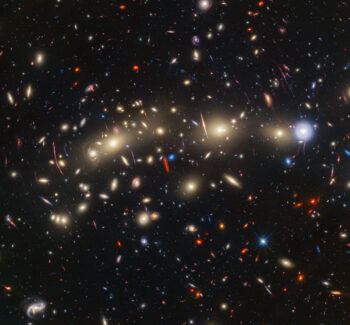
Panchromatic view of MACS0416, a galaxy cluster about 4.3 billion light-years from Earth. The image was created by combining infrared observations from NASA’s James Webb Space Telescope with visible-light data from NASA’s Hubble Space Telescope. The resulting prismatic panorama of blues and reds give clues to the distances of the galaxies.
NASA, ESA, CSA, STScI, Jose M. Diego (IFCA), Jordan C. J. D’Silva (UWA), Anton M. Koekemoer (STScI), Jake Summers (ASU), Rogier Windhorst (ASU), Haojing Yan (University of Missouri)
Astronomers once again have combined the observational powers of NASA’s James Webb Space Telescope and Hubble Space Telescope to create one of the most detailed and colorful portraits of the cosmos, just in time for the holiday season.
The new image, dubbed the Christmas Tree Galaxy Cluster by the research team that includes Texas A&M University astronomer Dr. Lifan Wang, combines visible light from Hubble with infrared light detected by Webb to showcase MACS0416, a galaxy cluster about 4.3 billion light-years from Earth. Because the cluster is able to magnify the light from more distant background galaxies through a phenomenon known as gravitational lensing, it has enabled researchers to identify magnified supernovae and even very highly magnified individual stars.
“We’re calling MACS0416 the Christmas Tree Galaxy Cluster, both because it’s so colorful and because of these flickering lights we find within it,” said University of Missouri astronomer Dr. Haojing Yan, lead author of one of two papers describing the scientific results. The paper, co-authored by Wang, has been accepted for publication in The Astrophysical Journal.
Wang, a member of the Texas A&M Department of Physics and Astronomy and the George P. and Cynthia Woods Mitchell Institute for Fundamental Physics and Astronomy since 2006, is part of a time-domain astronomy team that is using JWST to discover the universe’s very first supernovae, the oldest of which on record dates back to a time when the universe was more than 3 billion years old. The international collaboration, known as the Prime Extragalactic Areas for Reionization and Lensing Science (PEARLS), is led by Arizona State University astronomer Dr. Rogier Windhorst and credited with acquiring the data resulting in the discoveries.
One of the team’s tactics is to use the unparalleled observing power of Webb to search for objects varying in observed brightness over time, known as transients. In a 2017 white paper published prior to the launch of JWST, Wang and his co-authors predicted that the telescope would find a few such transients in a single shot using its powerful main imager, called the Near Infrared Camera (NIRCam). Wang cites the MACS0416 image and the 14 transients it contains as proof positive, noting that the discoveries are exceeding the team’s predictions.
“The JWST is discovering a large number of transient objects, mostly supernovae, in the universe,” Wang said. “Not only it is finding supernovae, it has also found stars in faraway galaxies that are magnified by the gravitational field of nearby foreground galaxies.”
